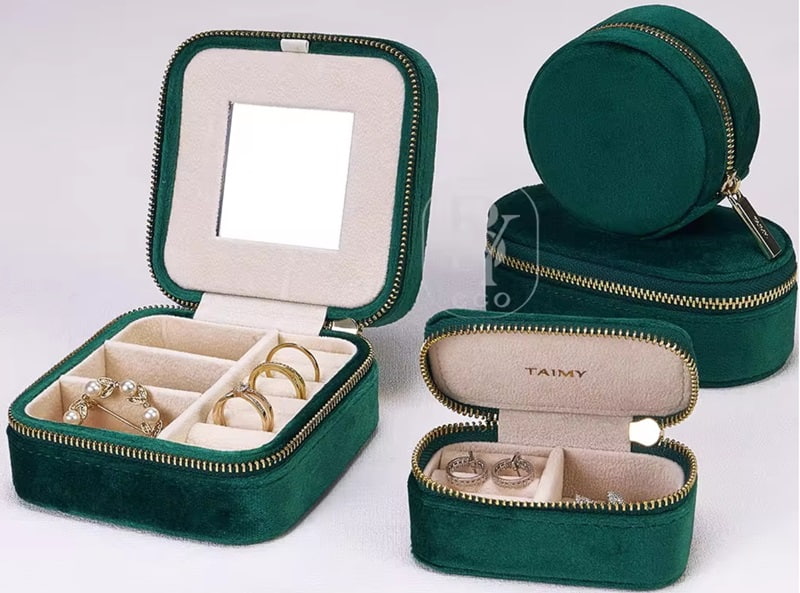You can share
- Share to Facebook
- Share to Google+
- Subscribe to our
- Share to Linkedin
- Share to Twitter

In jewelry packaging, velvet jewelry boxes have always been considered a symbol of high-end sophistication. Their soft texture, delicate feel, and elegant appearance elevate the presentation and protection of jewelry. For jewelry brands and packaging designers, understanding the production steps of velvet jewelry boxes helps control production quality and create packaging products that align with the brand image.
The first step in making a velvet jewelry box is to determine the overall design. Depending on the type of jewelry (rings, necklaces, bracelets, earrings, etc.), the size and structure of the velvet jewelry box will vary. For example:
Ring boxes are typically small and square, with a single or double internal slot.
Necklace boxes are larger, often square or rectangular;
Bracelet boxes emphasize length proportions and support structures to prevent the jewelry from sliding.
During the design phase, it's necessary to consider brand positioning, usage scenarios, and display needs, while also determining the appearance style (flip-top, drawer-style, magnetic, etc.) to provide standardized dimensions for subsequent production.

The texture of a velvet jewelry box mainly depends on two parts: the outer velvet layer and the internal support structure.
(1) Box Material: High-density grey board or wood is usually used as the support material to ensure a stable and non-deformable structure. The grey board thickness is generally between 1.5mm and 3mm, depending on the box size.
(2) Velvet Material: Velvet comes in various types, such as short-pile plush, flocked fabric, velvet, and flannel.
Short-pile plush: Delicate to the touch, suitable for high-end jewelry packaging.
Flannel: Soft luster, rich colors, often used in women's jewelry collections;
Flocked fabric: Moderate cost, uniform surface, often used in mass production.
High-quality velvet not only enhances the appearance but also effectively prevents scratches on the jewelry surface.
The lining of a velvet jewelry box is an important part of protecting the jewelry. Typically made of EVA, sponge, or PU foam, these boxes are cut into suitable slot shapes using molds to hold jewelry such as rings, necklaces, or bracelets.
* For ring boxes, the lining often features a layered slot design to hold rings of different sizes;
* For necklace or bracelet boxes, ribbons or slots are added to the lining for easy display and securing of the jewelry;
* For earring boxes, a multi-hole layout is often designed for easy display in pairs.
After the lining is completed, a velvet fabric in the same or contrasting color as the outer layer is pasted on, creating a unified style and a more upscale look.
This is one of the key steps in making a velvet jewelry box. It is usually done manually or semi-automatically:
(1) Cutting the Velvet Fabric: Allowing a certain margin according to the box size to ensure smooth corners after covering.
(2) Spraying and Bonding: Applying environmentally friendly adhesive evenly to the box surface and precisely bonding the velvet fabric. (3) Hemming and Corner Binding: Hand-pressing or roller shaping is used to prevent air bubbles and wrinkles.
This step requires extremely high precision; attention to detail directly affects the quality and durability of the velvet jewelry box.
After the outer shell is covered with fabric, the lining, opening mechanism, and decorative pieces need to be installed. Common accessories include:
Magnetic snaps or metal clasps: Used for closing the lid, improving the opening experience.
Ribbons or pull cords: Assist in opening the lid, enhancing ease of use;
Logo metal pieces or hot-stamped logos: Used for brand display, strengthening visual recognition.
After the lining is installed, check that it is flat and firmly attached to ensure the jewelry will not move during transportation and display.
Adding a brand logo to the velvet jewelry box is an important way to enhance brand recognition. Common customization methods include:
Hot stamping (gold/silver): Using high-temperature embossing technology, a metallic logo is applied to the velvet surface.
Screen printing/UV printing: Suitable for multi-color patterns or small-batch customization;
Embroidered logo: Used on some high-end velvet boxes to highlight craftsmanship details.
The brand logo should coordinate with the packaging color scheme, neither overpowering nor detracting from the overall high-end feel.
Creating an exquisite velvet jewelry box requires not only high-quality materials and superb craftsmanship but also structural rationality and brand visual consistency. From design and material selection to fabric covering and printing, every step determines the final product's grade and value.